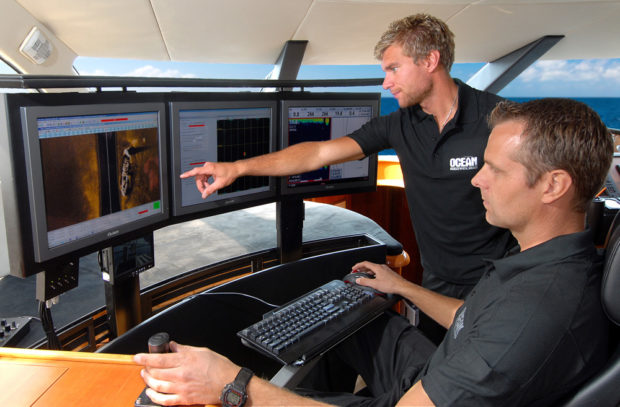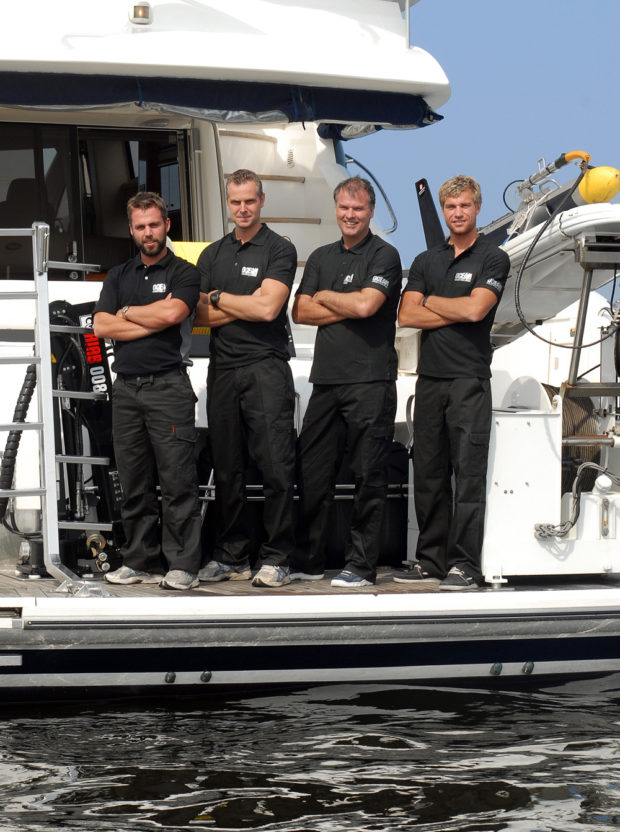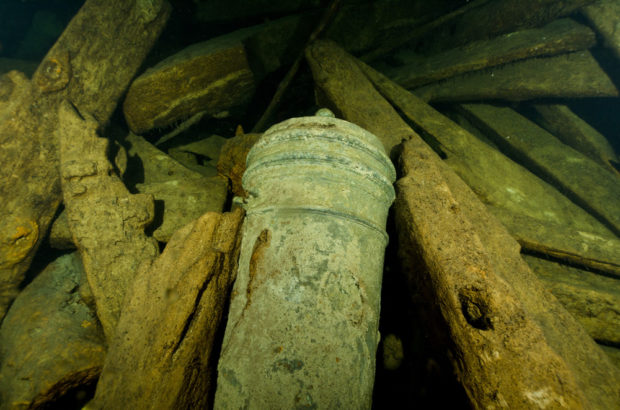Mars the Magnificent
Found! They think. Swedish tech divers believe they’ve discovered the wreck of the legendary and elusive Mars, flagship of their country’s navy, almost five centuries ago. Archaeologically, the find would be of global importance.
Text by Richard Lundgren – Photography by Ingemar Lundgren

The Year of Our Lord, 1564. May 31st, in waters off the island of Öland, along the southeast coast of Sweden.
Smoke from cannon fire is thick; heat and noxious gunpowder fumes permeate the air. Everywhere the clash of steel, blade on blade, incessant musket fire, the roar of cannon blasts. The sounds are deafening, punctuated by fearful screams of bravado as men fight for their lives, screams of agony as men die.
From one of a thousand cannons a metal missile screeches in to the Mars obliterating everything in its path. A railing disintegrates, stout oak beams vaporize. Metal shards and wood splinters become lethal shrapnel cutting down a weary gun crew confined below decks in a space that in a flash is just a smoldering, gaping hole in the ship’s side.
Blood is everywhere, the deck is slick and treacherous. Youngest members of the crew, terrified 12-year old deck hands, throw sand down so the men can fight, so the guns can be reloaded and fired… in hopes of winning the day. On the upper deck hand-to-hand combat is in full sway. The Swedish soldiers fight courageously to repel wave upon wave of enemy fighters who are boarding the mighty Mars from stem to stern.
The situation is desperate. It’s only a matter of time before the engulfing fires ignite the magazine, but surrender is unthinkable. This is anything but a gentleman’s battle. Capture will be a death sentence, death in a most gruesome fashion as a demonstration of the enemy’s resolve. In this conflict only the nobles can hope for mercy, for the ransom they will command.
The Danish-Lübeck soldiers are driven to capture Mars so they might claim a share of her bounty. It’s a prize that’s real to them and a world away from the royal ambitions of the noble lords and kings responsible for this conflict.

A web of grappling lines and hooks bind Mars to her attacker. The ships are locked rail to rail and despite their proximity both blast their guns at each other. It’s kill or be killed. Forty-eight pound cannon balls strike with the force of a thousand jackhammers, shattering bridge timbers, collapsing structure; for crew the ship has become an abattoir. And then an almighty explosion rattles Mars, the battleground that is her deck, lifts, casting combatants in every direction. The explosion is catastrophic, delivering a mortal wound to the mighty ship, which struggles and shifts as it begins to slip down into the frigid Baltic Sea. Together, Swedes and Danish-Lübeck scramble to save themselves. A raging funeral pyre, flames wildly consuming her, the proud flagship hisses and spits in her descent, the water around her mass boiling like the devil’s own cauldron. Steam rises, enveloping her bulk and then, like a ghost, she vanishes; Mars the Magnificent is no more, lost for centuries to come.

447 Years Later…
It’s May 2011, in waters off the island of Öland, along the southeast coast of Sweden.
A small group of divers survey the sea bottom with state of the art sonar aboard their research vessel Princess Alice. In these contemporary times the search for Mars the Magnificent is now two decades on, a hopeless endeavour some have said, considering anyone with an interest in the legendary ship has already tried and failed, among them Anders Franzen, famous for his discovery of the Vasa in Stockholm harbor decades before.
But all that’s about to change.
The divers’ unflagging commitment is about to pay off. The legendary Mars, once the most feared battleship in the world, will again be the talk of Swedish society. After 447 years in the deep darkness of this sea the Mars will be awoken from her slumber and the country’s history will be enriched in a way not seen since the discovery of Vasa and Kronan. A new chapter in the understanding of Swedish nautical history is about to be written.

“Guys, come here and have a look at this.” Christofer urges us to join him at the sonar station. The side scan has picked up on something out of the ordinary and he knows it. Through the months Christofer had seen many wrecks on the sonar but there was something different in his voice this time and I could tell.
In the 12 hours leading up to this moment, we’d been trying to define the limits of a debris field and to find something, anything that might be the source of the debris. Could this be it? A quick glance at the screen and I understood his reaction. And it didn’t take long for the rest of us to react. We were looking at a massive wreck site with a complete 130-foot (40m) long hull-side, cluttered with debris and artifacts of all kinds.
“What do you guys think?” Christofer asks. I was the first to respond. “We have her, we finally have her,” I said, as the reality of the moment crept up on me. Everyone was grinning, Fredrik and Anton joining in with Christofer and me. We were jubilant. Sure, we’d have to dive the wreck for confirmation but a great deal of effort had led us to this place and time and we knew in our hearts that the Mars was ours, that we’d made the discovery of a generation. Today was our day!

Landing on Mars
The contours of something huge slowly resolved as we descend to 230 feet (70m), eyes wide open and straining for a first glimpse of the prize. It was dark and cold – very cold – and I shiver. But if you’d asked just then I couldn’t have said if my shakes were from the cold or flat out excitement. Weeks had passed since the side scan hit on the Mars and I was like a kid in a candy shop. I couldn’t wait to get down there to quell the anticipation. Terms of a seabed survey contract obliged us to leave the wreck after that memorable day of discovery. At the time I remember thinking, “This is insane!” After 20 years of searching and, finally, success, and we have to leave the site unmarked, unclaimed and unprotected until a later time. It was nerve wracking. Now that Mars was in our sights would others zero in on the wreck as we had, or by stealth or by chance?
In the beam of Fredrik’s powerful HID light I glimpse a looming presence below. It is certainly a wooden hull and soon its magnitude is apparent to us. Before us is an impressive hull side of solid oak and as we move forward long rows of cannon ports become visible. Though time has taken a toll on these timbers there is an overpowering sense of this ship’s might. I begin laughing into my regulator. “We’re the first to land on Mars,” I say to myself.

Swimming southeast along the hull toward what seems to be the stern area we come upon an unexpected sight. The scene baffles and delights us. Here is what must have been Admiral Bagges private quarters. Not only can we see this private area, we can enter it as well. As we swim into the dim cabin my eyes are wide open, recording everything, storing impressions. I’m thinking, “It’s likely here that Admiral Bagges’ fabled treasure is stowed, hidden away from prying eyes. It was this trove of valuables that the Danish-Lübeck attackers sought and a reason for their unrelenting fight to capture the vessel. In the heat of that chaotic battle, did someone find the loot or was it lost with the ship, and still to be found? Historical records tell us nothing but I have a feeling future dives might prove revealing! The treasure, real or not, eludes us and we move out, pressing ever deeper.
Closing in on the seabed we swim into a milky mist where visibility abruptly is reduced from 70 feet (21m) to just a few feet. We tighten up our formation and signal ‘okay’ to each other with our lights. In the limited vis I spot a familiar shape and I head torward it. A cannon! A very big bronze canon I estimate at 15 to 16 feet (5m) in length. Its green patina reflects in my light beam. “Cannon, Cannon!” I shout out loud into my mouthpiece. Immediately, I hear the words echo and it takes me a few seconds to realize that it’s not echo, but Fredrik yelling the same words as me. As I turn to him I see why he’s excited and again, I am awestruck. Fredrik has found a pile of no fewer than seven cannons of different calibers. The size of the dolphins, handles, grapes, and rear handles of the larger ones are astonishing. This is better than even the best museum exhibit. The sight is the manifestation of my wildest dreams. Carefully and gently I start wiping sediment off the back end of a cannon that’s close at hand. I feel contours, something in relief; I peer intently and see that it’s a crest. Almost immediately I realize the design is familiar as cells of recognition fire off in my brain. It’s the heraldic shield of the Swedish King Gustav Vasa.
This is critical evidence and from years of research the presence of this insignia supports our belief that this wreck is that of Mars the Magnificent.

What Lies Ahead
The battle between the Swedish and Danish-Lübeck fleets off the northern tip of Öland, raged for two days. In the end, the Swedes were defeated. It’s said the Mars lost its ability to navigate, at which point the enemy fleet surrounded her, anticipating capture. Led by the legendary Admiral Jakob Bagge, the Swedes offered strong resistance, however, the day was lost when the Mars caught fire and exploded. The ship has remained lost and untouched for 447 years.
If our find proves to be the Mars, then we have on our hands a much sought after relic comparable to Sweden’s Vasa and Britain’s Mary Rose. The County Administrative Board of Kalmar has placed a moratorium on diving, fishing and anchoring at the site.
The wreck unquestionably will be important for research, says Andréas Olsson, the head of archaeology at the Swedish Maritime Museum. To that end a research project is now underway. In September a scientific group was formed, headed by Olsson. As discoverers of the ship we have earned two places in the group. The diving team, archaeologists of the Swedish Maritime Museum and university researchers will now work collaboratively to confirm identity of the wreck, map out the wreck site and determine the best methods to further protect, document and possibly even excavate Mars the Magnificent.

Click for more about Ocean and Discovery







